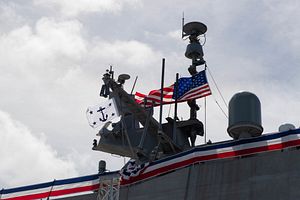The U.S. Navy commissioned the littoral combat ship (LCS) USS Billings (LCS 15) during a ceremony in Key West, Florida, on August 3. The Billings is the eighth of the Freedom variant and the 17th LCS overall to join the fleet. The warship will be homeported in Mayport, Florida.
The U.S. Navy’s LCS force is divided into the Independence and Freedom variants. Building of the Freedom-class is headed by Lockheed Martin at the Fincantieri Marinette Marine (FMM) shipyard in Marinette, Wisconsin. The construction of the Independence-class is managed by Austal USA in Alabama. The Austal and Lockheed shipyards are each optimized to build two LCS per year.
Lockheed Martin has delivered eight Freedom-class ships to the U.S. Navy to date. As my colleague Steven Stashwick reported in May, the company is also spearheading an effort to enhance the combat capabilities of both LCS variants in a two-phased plan. According to a report by the Pentagon’s office of Operational Test and Evaluation from January 2o18, the two variants are not suitable for high-intensity combat.
According to the U.S. Navy press release, the Billings “is a fast, agile, focused-mission platform designed for operation in near-shore environments yet capable of open-ocean operation. It is designed to defeat asymmetric ‘anti-access’ threats such as mines, quiet diesel submarines and fast surface craft.” As I noted previously:
[W]ith 40 percent of the hull reconfigurable, both LCS variants use an open architecture design, enabling the warships to be fitted with interchangeable so-called mission packages providing capabilities for surface warfare (SUW), anti-submarine warfare (ASW), and mine countermeasures (MCM) missions in the littoral zone. The ASW warfare package is expected to become available to the fleet in 2019, while the MCM package will be available in 2020.
Standard armament of a Freedom-class LCS includes a 11-cell Raytheon RIM-116B SeaRAM missile-defense system, a 57-millimeter naval gun, and Mark 5o torpedoes.
In July, the U.S. Navy completed structural testing of the Surface-to-Surface Missile Module (SSMM), part of the SUW mission package. The SSMM, a 24-shot vertical launch system designed to engage surface targets with AGM-114L Longbow Hellfire missiles, will be installed on both the Independence and Freedom variant.
“Delays in the development of the SSMM led to the initial deployment of a more limited surface warfare [SUW] mission package aboard the LCS, exchanging Hellfire Missiles for rigid hull inflatable boats and boarding teams,” I wrote in 2017. “The package also encompasses two 30-millimeter machine guns, two MQ-8B Fire Scout unmanned aerial vehicles, and an MH-60S Seahawk helicopter.”
Another Freedom-class LCS, the future USS Indianapolis, successfully completed acceptance trials on Lake Michigan in June. Acceptance trials are the last major step before the delivery of a ship to the U.S. Navy.

































